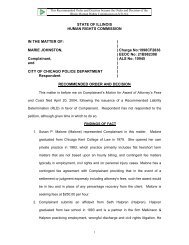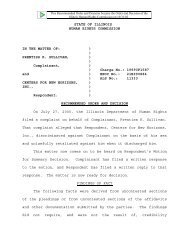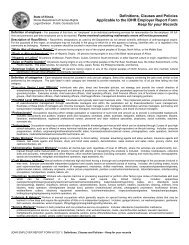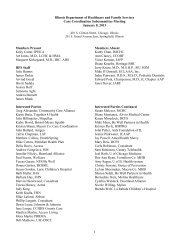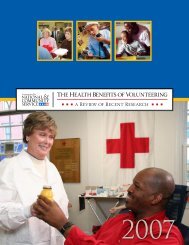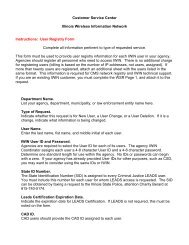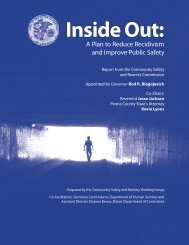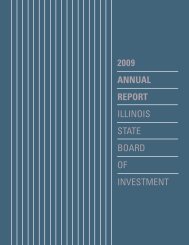Level <strong>of</strong> Service/Case Management Inventory (LS/CMI)General information. The LS/CMI system is a comprehensive assessment instrument thatassesses risk <strong>and</strong> criminogenic needs. Similar to COMPAS, it serves as a fully functional casemanagement tool. The LS/CMI was developed by the same researchers who developed the LSI-R <strong>and</strong> it is owned by the same company (Multi-Health Systems). It was created to reflect theexp<strong>and</strong>ing knowledge base about <strong>of</strong>fender risk assessment that has emerged since thedevelopment <strong>of</strong> the LSI-R.Domains. The instrument was updated to assist correctional pr<strong>of</strong>essionals with the exp<strong>and</strong>edduties required <strong>of</strong> them, namely the focus on behavior change through programmaticinterventions <strong>and</strong> referrals. The revision includes refining <strong>and</strong> combining the 54 LSI-R items into43 items. In addition, assessors can indicate areas <strong>of</strong> <strong>of</strong>fender strength, serving as protectivefactors.As indicated in Table 1, the LS/CMI is comprised <strong>of</strong> eleven sections. Section 1 produces the totalrisk/need score based on the 43-item assessment. Sections 2, 3 <strong>and</strong> 4 assess mitigating oraggravating factors that can affect risk <strong>and</strong> need levels indicated in the first section. Section 6documents a pr<strong>of</strong>essional or administrative override. The remaining sections deal exclusivelywith case management considerations, including assessing responsivity concerns.SectionTable 1: LSC/MI Section FunctionsContent1. General <strong>Risk</strong>/Need Factor Total <strong>Risk</strong>/Need Score2. Specific <strong>Risk</strong>/Need Factors3. Prison Experience/Institutional Factors4. Other Client Issues5. Special Responsivity Considerations6. <strong>Risk</strong>/Need Summary <strong>and</strong> Override7. <strong>Risk</strong>/Need Pr<strong>of</strong>ilePersonal problems with criminogenic potential (e.g., racistbehavior), history perpetrationCrucial institutional considerations including history <strong>of</strong>incarceration <strong>and</strong> barriers to releaseSupplementary psychological <strong>and</strong> physical health, financial,accommodation, <strong>and</strong> victimization itemsDominant responsivity considerations from clinical research <strong>and</strong>correctional opinionSummarizes risk/need scores <strong>and</strong> allows for overriding scorebasedrisk/need levelGraphically summarizes the Section 1 subcomponent <strong>and</strong> risk/needlevel scores8. Program/Placement Decision Record <strong>of</strong> major classification decisions (e.g., program placement9. Case Management Plan10. Progress Record11. Discharge SummaryLists criminogenic needs, non –criminogenic needs, <strong>and</strong> specialresponsivity considerationsLog <strong>of</strong> activities designed to measure change resulting from casemanagement strategiesSummarizes information useful if the <strong>of</strong>fender returns to custodyor community supervision4
Research <strong>and</strong> validation. Extensive scientific validation has been conducted on the LS/CMI’spredictive validity. A review <strong>of</strong> the literature suggests the LS/CMI as a valid <strong>and</strong> reliableassessment tool across a range <strong>of</strong> <strong>of</strong>fenders. Furthermore, a 2004 meta-analysis <strong>of</strong> the LS/CMIconcluded that the instrument is as predictive <strong>and</strong> reliable with females as it is with males. 9 Theresearchers also determined the instrument to be effective across a range <strong>of</strong> settings including,probation, probation, <strong>and</strong> prison/jail. 10III.Other <strong>Assessment</strong> ToolsOhio <strong>Risk</strong> <strong>Assessment</strong> System (ORAS)General information. In collaboration with the Ohio Department <strong>of</strong> Rehabilitation <strong>and</strong>Corrections, researchers at the University <strong>of</strong> Cincinnati (led by Dr. Ed Latessa) developed theOhio <strong>Risk</strong> <strong>Assessment</strong> System (ORAS), which assesses individuals at several points in thecriminal justice system. Ohio developed ORAS with two specific goals in mind: first, to promoteconsistent <strong>and</strong> objective assessment <strong>of</strong> risk throughout the criminal justice system; <strong>and</strong> second, toimprove communication <strong>and</strong> avoid duplication <strong>of</strong> information from one system point to the next.Tools <strong>and</strong> domains. Five assessment instruments were created: Pretrial <strong>Assessment</strong> Tool,Community Supervision Screening Tool, Community Supervision Tool, Prison Intake Tool, <strong>and</strong>Reentry Tool. The Pretrial <strong>Assessment</strong> Tool is designed to predict risk <strong>of</strong> failure to appear at a futurecourt date <strong>and</strong> risk <strong>of</strong> arrest. It consists <strong>of</strong> seven items from four domains: criminalhistory, employment, substance abuse, <strong>and</strong> residential stability. The Community Supervision Screening Tool identifies moderate- to high-risk <strong>of</strong>fenders inneed <strong>of</strong> the complete assessment instrument. It is a four item instrument designed toquickly identify low risk cases that do not need the full assessment. The Community Supervision Tool assists in the designation <strong>of</strong> supervision levels <strong>and</strong>guides case management for <strong>of</strong>fenders in the community. It consists <strong>of</strong> 35 items fromseven domains: criminal history, education, employment <strong>and</strong> finances, family <strong>and</strong> socialsupport, neighborhood problems, substance abuse, antisocial associations, <strong>and</strong> antisocialattitudes <strong>and</strong> behavioral problems. The Prison Intake Tool prioritizes prison treatment based on the likelihood <strong>of</strong>re<strong>of</strong>fending. It consists <strong>of</strong> 31 items from five domains: criminal history, education,employment, <strong>and</strong> finances, family <strong>and</strong> social support, substance abuse, <strong>and</strong> criminallifestyle. The Reentry Tool predicts the likelihood <strong>of</strong> recidivism <strong>and</strong> was designed to beadministered within six months <strong>of</strong> release. It consists <strong>of</strong> 20 items from three domains:criminal history, social bonds, <strong>and</strong> antisocial attitudes.9 Williams, K. , Andrews, D. , Bonta, J. , Wormith, J. , Guzzo, L. <strong>and</strong> Brews, A. , 2009-03-04 "The Level <strong>of</strong>Service/Case Management Inventory (LS/CMI): Reliability <strong>and</strong> Validity in Female Offenders" Paper presented atthe annual meeting <strong>of</strong> the American Psychology - Law Society, TBA, San Antonio, TX . 2010-03-11from http://www.allacademic.com/meta/p295679_index.html10 Ibid.5



